Not many people realize how easily their water stockpile can put them and their family at risk in a crisis.
Are you one of those people?
Bacteria, viruses, and even parasites can thrive in water that isn’t fresh. That’s when it becomes unsafe to drink. Such biological contaminants are common, although some of them are not dangerous. Yet I’m sure you hate the thought of knowing harmful parasites could be living in your body for years.
In this article, I will tell you how to properly check if your water stockpile has been compromised, how a faulty water stockpile can affect you, what can ruin your water, and how to keep it safe.
How a Compromised Water Stockpile Can Affect You
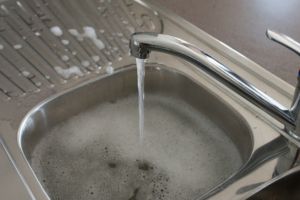 Picture this scenario: Disaster has struck, and the city has cut all water resources. Your water stockpile has been compromised too.
Picture this scenario: Disaster has struck, and the city has cut all water resources. Your water stockpile has been compromised too.
You don’t have a way of knowing that, so you and your loved ones keep drinking from it, washing yourselves with it, cooking with it, etc.
Related: How Long Can You Store Water Before It Becomes Unsafe to Drink?
Hospitals are overwhelmed, and pharmacies have been looted. What happens when your family gets sick, and you don’t know why?
- Pesticide and Heavy Metal Poisoning – These elements can be present right now in your water stockpile. You’ve worked hard to put together that water stockpile, and it might already be contaminated.
- Life-Threatening Illnesses – The most common harmful bacteria found in contaminated, untreated water include E. coli, legionella pneumophila, salmonella, cryptosporidium, Hepatitis A, cholera, and dysentery.
These bacteria can be fatal if not addressed promptly, and they start with nothing but nausea, stomachaches, and the feeling that you are unwell.
Would you risk your life by being infected with hard-to-pronounce bacteria that you can’t even see?
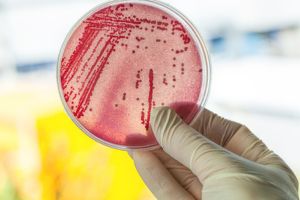 At least now you can get some meds and antibiotics to counter some of the pesticides that make their way into your body. But how are you going to manage it during the next crisis?
At least now you can get some meds and antibiotics to counter some of the pesticides that make their way into your body. But how are you going to manage it during the next crisis?
Pharmacies will run dry, and your only solution will be to make your own stockpile of these to keep you alive.
It’s what I did during the pandemic. I found a useful trick that can help you stockpile prescription antibiotics, and it’s completely legal. Here’s what you should do.
Filtering water isn’t as hard a process as those YouTube ”survivalists” make it out to be. And it’s not expensive if you want a filter to do the job properly. I bet you don’t want to spend your hard-earned money on those overpriced filters made in China or India. You should learn how to filter the water yourself!
I’ve tried the activated charcoal water filter, which I made myself using the guidelines from the Wilderness Long-Term Survival Guide.
It teaches you how to properly filter your water as well as:
- How to collect clean, drinkable water from plants.
- How to turn medicinal plants into natural remedies.
- How to cook in the wild with no gear.
- What plant you should burn in the woods.
- Why you should set noodles on fire.
- How to recognize useful plants like an expert forager.
- How to extract salt from plants.
Check out the other ways to filter your water in this guide!
How to Tell if Your Water Stockpile Has Already Been Compromised
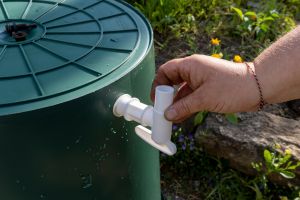 I routinely check my water every two weeks just to make sure I’ll never be out of it when I need it most.
I routinely check my water every two weeks just to make sure I’ll never be out of it when I need it most.
Inspecting it regularly is crucial so you will never be caught off guard.
I’ll show you exactly how to do it:
- Check for any changes in the color of the water. It should be clear, and any small change in color could indicate contamination. Your job will be even harder if you’re using damaged or stained barrels as this will create confusion, especially if your sight isn’t the same as twenty years ago.
- Fresh water should have no smell at all. If you smell the slightest foul or unusual odor, it can be a sign of bacterial growth or chemical contamination. Many barrels or old plastic bottles can develop an unusual smell if not washed properly before stockpiling anything in them.
These are the most obvious ways to tell if your water stockpile has been compromised. Still, you should do more than that. - While it’s not advisable to taste potentially compromised water, if you do notice an unusual taste, it could be an indicator of contamination. If you have ever stored water in an old metal bucket, you could sense the slight taste of metal and rust. That’s due to the iron concentration that contaminates the water.
- You should also visually check for any particles or sediments at the bottom of your storage container. These can indicate that foreign substances have entered the stockpile. Heavy particles will always go to the bottom, so you can avoid them just by drinking the fresh water at the top without shaking the bottle to raise the impurities.
- Inspect the storage containers for any cracks, leaks, or signs of deterioration that could allow contaminants to enter. You should double-check this step if you’re storing any water outside.
What Should Your Water Stockpile Look Like?
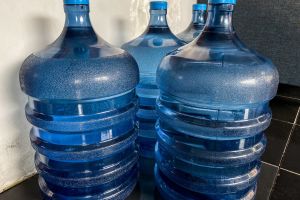 The stockpile should be sealed tight to avoid such contamination.
The stockpile should be sealed tight to avoid such contamination.
If you store the water outside, you should avoid exposure to extreme temperatures and direct sunlight. Even air can degrade the quality of stored water. Viruses and bacteria can grow easily under the right conditions.
The Ultimate Threat to Your Water Stockpile
Many projects out there are real game-changers when it comes to stockpiling the most important resource.
If you plan to stockpile water, always store it in food-grade containers designed specifically for water storage. Avoid using previously used containers that may have held chemicals or other non-food substances.
Ensure all containers are tightly sealed to prevent air, insects, and other contaminants from entering. Keep your water stockpile in a cool, dark environment to minimize the risk of bacterial growth and chemical reactions caused by light and heat.
Add water preservatives to your stockpile to inhibit the growth of bacteria and algae. Follow manufacturer guidelines for proper use.
Rotate your water stockpile every six to twelve months. Use the oldest water first, and replace it with fresh water to ensure a constant supply of potable water.
If taking care of your water stockpile sounds like too much work, you can always try this backpack-sized water generator.
I could not imagine outliving a crisis without this air fountain. It produces 40 gallons a day right from your property without being connected to the power grid!
My family and I have been using it for just over a year now, and it truly delivers.
This article was first published on Self-Sufficient Projects.
You may also like:
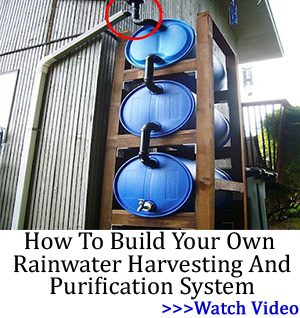 Long Lasting Pork Rillette Recipe (With Pictures)
Long Lasting Pork Rillette Recipe (With Pictures)
How to Protect Your Water Stockpile from Looters and Intruders (Video)
What Happens When the Government Becomes Your Worst Enemy

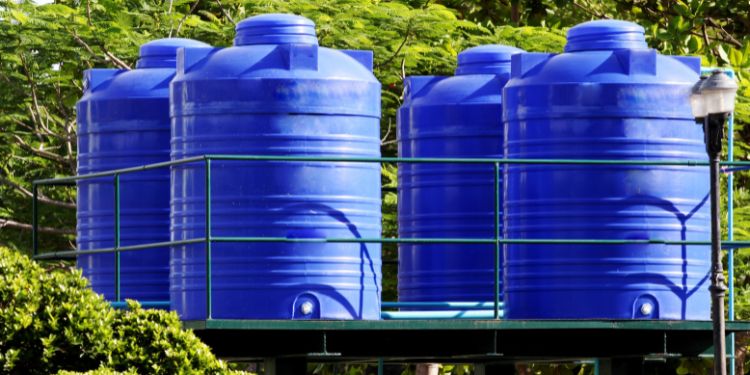


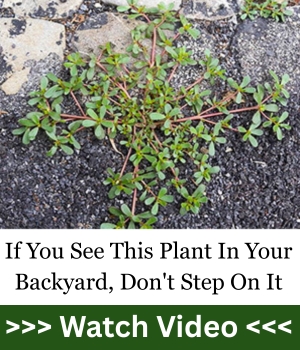



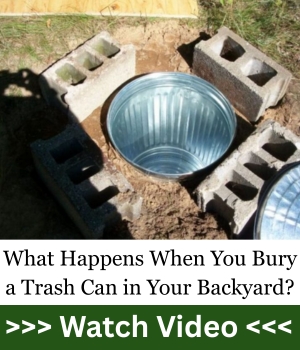
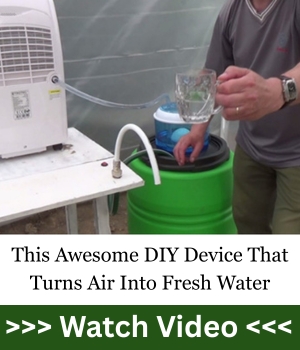





There are ways to treat water. No point panicking. High quality filters, reverse osmosis, chlorine dioxide…not bleach. Let’s concentrate on solutions instead of panic. Water articles have been rehashed so many times that people stop listening.
Hi, Farmer. You are so right. To boot, the complacency that envelopes uneducated people is toxic. They tell themselves that they would take care of that problem when it arose. What they don’t understand is that after 3 days of non-moisture absorption, the body starts to shut down. All said, by repetition, it still remains as a fact, regardless how these folks think, that water is a main rule of continuous survival. Without it, you will perish!
I recently went through the incompetent money grubber power outage in Texas after a minor storm. 4 million people in 10 counties. No power. I was again reminded water and lack of clean water will turn the most sensible person into a cannibal. If any of these articles need repeating 10 times or more, it is this one about water.
Get over it and the rehashing. Exercise your finger and delete. We just went through having to get water from a swimming pool. This is not a debate. This is your life. My life. More information and reminder the better.
Thank you Claude.
The part about keeping water out of sunlight is 100% wrong.
Ask any real expert, and they will tell you sunlight actually purifies the water, so this part needs correcting.
Temperature changes are another thing.
Store whatever below the thermocline where the temp is constant, build your root cellar below it too.
Remember to put in a French drain & build the foundation the same way a house foundation would be built, 6 inches of 3/4 inch stone, then concrete over it.
If you do something the right way the first time, there won’t be a second time.
Anon, keeping it out of sunlight is better if the storage container is plastic, as the sun can cause the plastic to break down faster.
Water will be a war between state’s as we get more and more illegals into this country. There was a CIA report years ago that future wars would be fought over water, not for oil.
Water, air and food are basic human needs that we humans would turn into a civil war beyond what the average prepper could dream of.
This 2024 election in November 5th is a fight for our American rights and sovereignty. Please study history, we are reliving the Carter years. If Harris-Walz get into office your freedoms will be gone overnight.
Water storage maybe come illegal or very heavily taxed beyond the price most fixed income seniors can afford.
Around 1960-61, CBS Playhouse 90 aired a television version of a play or book called, Alas Babylon. The part that stuck in my craw all these years was depicting how pleasant everyone was while food, supplies, and services were abundant, but once the supply lines lowed to a stop, ….. it was “Back to the Jungle.” When the bombs were dropped and the trucks ceased to roll, the food supplies lasted about three days and everyone was beating the shit out of each other to get to the last loaf of bread.
i”am a senior citizen., retired and a survival bug. i also drink a glass of red wine every evening with dinner. i use these one gallon jugs for storage of water. my water is doubled filtered from my well.,and bottled with 4 to 6 drops of chlorine sealed and stored in a dry dark place. each is dated and marked and the oldest is from 2015. what could go wrong with this proceedure since i”ve not seen any changes in color or smells. your advise and or comments are welcomed. thanks.
Water water everywhere but never a drop to drink as the bureaucrats will regulate and tax or fee us before we can consume water utilities operated by a government agency.
Get our water filters and supplies to dig a well before these progressives control our lives soon.
Purification of water has always been a problem. Now, here is a method that works well and have done so for a few thousand years. Use wine and non-permeable containers, like glass. After straining and settling water until it is clear, allow it to stand in sunlight for a few hours,(doesn’t mater if it is cloudy, ultra violet radiation goes through anyway). After being “sunkissed”, add wine to provide (a cheep red wine works best) and dilute in water until you have an alcohol content of at least 1% by volume. 2% would be overkill. Red wine has tannin which helps kill bacteria along with the alcohol. It worked for Jesus and his buddies.
So long as the container is air tight, the chlorine will stay effective. Once opened the chlorine will dissipate and loose its antiseptic properties.
Unfortunately, it’s been my understanding that liquid chlorine bleach (laundry type or cleaning types such as Clorox etc.) will NOT last, even in factory sealed bottles. I have recently opened a few bottles, gallon sized and liter sized, that hadn’t been opened , and when I did so, there was ZERO scent of bleach in them. I’m sure that means it’s “expired” so far as effectiveness from my reading of the subject.
At this point I now have around 4 gallons of this “liquid”, and was planning to ask if there were some use for it that isn’t water purification/disinfecting. This seems the perfect timing and location to bring it up, so if anyone has an idea of what it could be used for, I’d appreciate learning it.
Get a really really good rocket stove and boil the hell out of
any suspect water. It will take a while but you will have safe
water.
Rocket stoves are generally forgotten about in the prepper
community.They will use almost any wood product and
pine cones work really well.
When the SHTF gets here you’ll have plenty of time to work
on things that you don’t think about on daily basis.
Great info
Thank you
Use your empty canning jars for water storage in your house. Whenever you can a batch of anything, add a jar of water to fill the canner if it’s not full. Water bath or pressure canning, both are sufficient to long term store your regular drinking water. and glass jars don’t deteriorate with time.